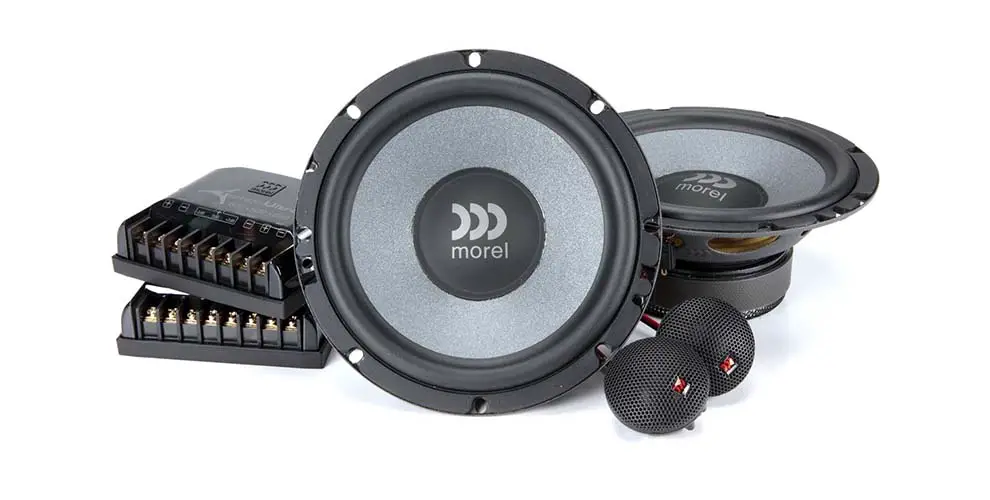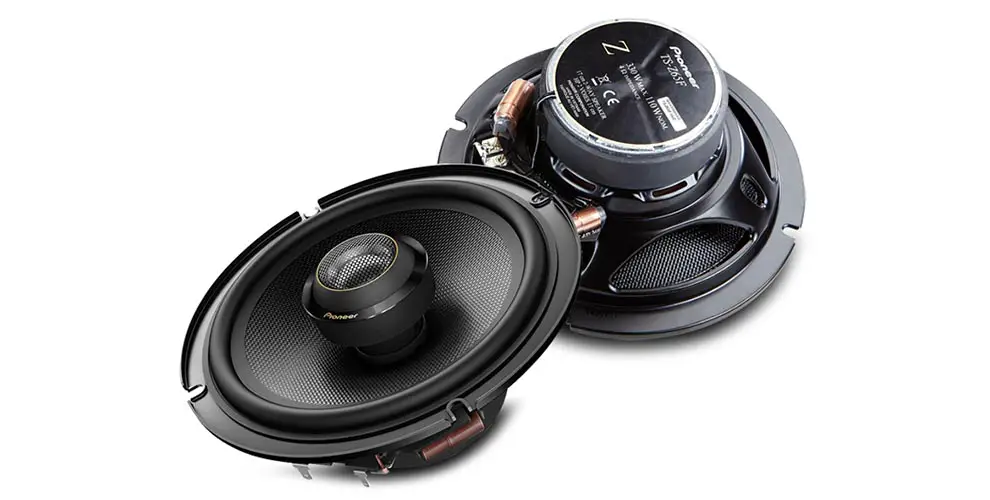In the competitive world of car audio, most enthusiasts immediately envision walls of high-powered amplifiers and boxes of ridiculously oversized subwoofers that require a small-town power substation to run.
And while these aspects of car audio – especially in sound-off competition circles – definitely bring the “cool factor” to the circuit, there are other elements often overlooked, but which are just as important when considering sound quality: component and coaxial speakers.
Perhaps one of the most often-asked questions we hear is, “What is the difference between coaxial and component speakers?” – and in this post, we’re going to answer it, while also providing a plethora of information about both types.
Table of Contents
Component speakers

A component car speaker is a car audio speaker essentially matched for optimal sound quality.
Offered by all high-end auto sound manufacturers, component speakers typically include a pair of tweeters (for high frequencies) and mid-bass drivers (to reproduce midrange frequencies) that are matched with a crossover that limits the frequency range each speaker can accurately reproduce, a tactic aimed at limiting harmful distortion and other unpleasant elements.
Now, while separate tweeters and mid-woofers may mean a bit more work during the installation phase, years of enjoyment will be experienced thanks to the advantages component speakers bring. Much like subwoofers are specifically designed to handle ultra-low, wall-shaking bass frequencies, the parts of a component speaker system have been engineered to deliver what tweeters and mid-bass drivers do best: Deliver clean, ear-splitting highs and rich mid-tones, respectively.
Coaxial speakers

Coaxial speakers differ from component speakers in that the individual driver units radiate sound from the same point or “axis;” depending on the application, there are two general types of coaxial loudspeakers – one boasts a compact design using two or three speaker drivers (usually utilized in-car audio) and the other is a two-way high-power design for professional audio (also known as a single-source or dual-concentric loudspeakers). Obviously, for the purpose of this post, we’re going to focus on the compact design relating to mobile audio applications.
In the car stereo world, “coaxials,” as they’re known, are two- or three-way loudspeakers in which the tweeter or the tweeter and a midrange driver are mounted in front of the woofer, obstructing it partially.
The advantage of this design is the ability to take up a smaller area, thus the coaxial speaker’s popularity in the mobile audio scene; there are some professionals who warn against a design such as this due to possible restrictions from the woofer area, but you can rest assured knowing the low-frequency sound waves from the woofer are not reduced to a significant degree by the drivers in their path.
The coaxial design was popularized in the 1970s with Electronic Industries, Inc. of South Holland, Illinois, which introduced the general concept in May of 1973. Jensen Loudspeakers introduced a retail model the following month, with designs from Sparkomatic, Clarion, Infinity, and other brands coming soon after.
Because we here at 99CarStereo bring with us the extensive knowledge and experience surrounding all things car audio, we understand that generalizations about which speakers are “better” than others can be a bit misleading. We believe that getting the best speakers for your vehicle depends on your specific requirements, and this should be considered before choosing a speaker system that best matches them.
Irrespective of all that, the decision to go with coaxial or component speakers is a major one to make when planning out that ultimate car audio system, and as such, it’s important to be armed with a working background regarding each of these speaker types.
The Major Differences Between Component and Coaxial Speakers
To begin with, coaxial speakers are often referred to as “full-range” loudspeakers due to the fact that all the necessary drivers to create sound – tweeter, woofer, mid-bass driver, et al. – are contained in one piece. On the flip side of this coin are component speakers, which separate these elements into individual pieces, each designed to deliver a frequency of the music at its absolute best.
To be clear, you have likely already seen and heard coaxial speakers in action – most factory car audio systems consist of a coaxial setup, and they’re more common than component setups for reasons we will get into in just a bit.
So, to break it down: Coaxial speakers are essentially car speaker systems in which all the components are combined in one “chassis,” so to speak; often, the framework consists of a woofer and a tweeter attached somewhere on the top or on a pole-mounted across the middle of the woofer.
Most coaxials also include simple, built-in crossovers to “direct” the correct frequencies to the corresponding drivers.
Check out the following video to give you a better idea of what coaxials look like and how they’re typically installed:
When it comes to component systems, you can think of these – as we alluded to above – as systems containing separated-out drivers – this means you can install different drivers (components) at various locations throughout your vehicle.
This is an interesting video highlighting component speakers:
At the end of the day, the decision to use either coaxial or component speakers in your ride comes down to what you’re looking for in a speaker system.
- Better Sound Quality – Consider component speakers if you place enhancing your listening experience atop the heap of priorities. Component car speakers have been coveted by many competition-level experts for their superior sound reproduction, courtesy of those separated drivers. They are also able to accurately separate different frequencies across the spectrum, delivering additional and more precise bass from the woofer and clean highs from the tweeters.
- Customization Capabilities – Without a doubt, if you are building a custom car audio system from scratch, component speakers are the way to go; their advanced design provides an opportunity to experience optimal sound quality by installing different drivers wherever you desire.
- Easier Install – With the aforementioned benefits of component systems being said, you either need to boast reliable technical skills or be prepared to spend extra money to pay for a pro installation if you want to enjoy those benefits; with coaxial speakers, installation is relatively simple and fast.
- Lower Expense – Coaxial speakers generally bring with them a smaller price tag compared to component systems; if you’re working with a strict budget, coaxials offer the most cost-effective solution. Also, coaxial speakers run just fine without outboard power amplifiers, meaning you can drive them with the power put out by most receivers/radios (head units); with components, it’s a different story.
Closing Thoughts
Without a doubt, ease of installation and lower price are the primary reasons folks go with coaxial speakers for a mobile audio system project, and if a vehicle has only one speaker per door panel, the better option is a coaxial arrangement, indeed. What’s more, most listeners find high-end coaxial speakers sufficient enough for everyday sound.
However, for listeners who value ground-thumping bass and audiophile-esque audio from their front soundstage, an advanced car speaker system featuring component speakers is the only way to go. Component speakers provide better sound quality as compared to coaxials, generally speaking.
If you find yourself with any additional questions after reading this post, please comment beneath it and we will get back to you as soon as possible!

